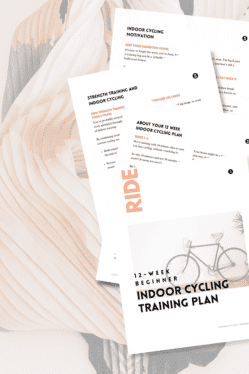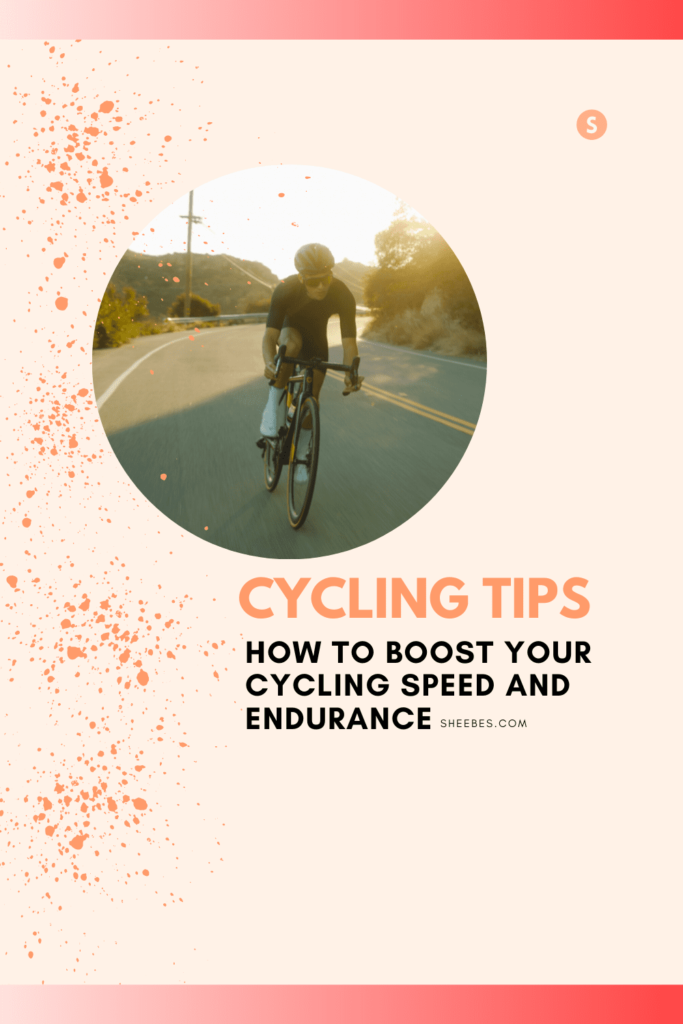Whether you’re brand new to cycling or a seasoned pro, you’ve probably gotten a taste of speed on your bike, and you’re craving more of it.
Sound about right?
But now you may be wondering: How do I train to be a faster cyclist? Why am I not getting faster at cycling?
You’re in the right spot because, in this post, we’ll talk about how to improve your cycling speed.
We’ll run through some questions about where you are today with your cycling and where you can improve, given your current cycling routine.
Let’s get started.

Whether you’re a runner looking for running tips or a cyclist searching for cycling advice, this site is here to help you elevate your fitness game.
Affiliate Disclosure: I’m here to help you grow as a rider and runner. So to keep things running smoothly and the content free, I participate in the Amazon Services program and select affiliate networks. So, when you click on those affiliate links, I earn a small commission at no extra cost to you.
HOW TO IMPROVE YOUR CYCLING SPEED
Cycling faster means a bit more workload and stress on your system so we have to analyze what you’re doing every week to prevent injury and overtraining.
Let’s figure out where you stand today with these 5 questions so that we know how to plot out your journey to getting faster on your bike.
1| What’s your cycling speed today? You can measure your average speed through an app (such as MapMyRide or Strava), a fitness watch, or a Garmin bike computer.
We’re only looking at your average speed, which will vary from day to day, and may be different from your friend’s cycling stats because of:
- Your bike. A road bike will take you farther and faster than a heavy mountain bike.
- The terrain. How hilly is it?
- Weather. Are you battling a headwind? Is it hot and humid?
- Your leg strength
- Stress and energy levels. Are you exhausted? Stressed from work? Tired legs from a previous bike ride?
- Your age
Are you curious about where your cycling speed lands? Let’s have a look at the average bike speed by experience:
- The average bike speed for beginners is between 10 to 15 mph.
- An intermediate cyclist might have an average cycling speed between 16 to 19 mph.
- And an advanced cyclist might have an average cycling speed between 20 to 25 mph.
2| Are you doing mostly conversational, easy rides? Interval training once or twice a week will train you to cycle fast.
3| How many days a week are you riding your bike? Do you ride your bike sporadically throughout the week? More days of cycling can help you get faster. Add in more days to build a cycling fitness base and from there, you can layer your cycling speed on top of this base.
4| Do you do any cross-training such as weight and resistance training? If you do, how many days do you spend on cross-training? A day or two of cross-training will build your strength to support cycling faster.
5| Do you practice and refine your cycling technique? Every ounce of energy you produce on the bike needs to be laser-focused on one thing only—moving you forward fast. You have to grab all that energy and direct it to where it needs to go—into your pedals. And one way to focus your energy and power is by refining your pedal stroke. We’ll go into an exercise below to help you fine-tune your pedal stroke.
Now that you have a good idea of what you’re doing today, let’s talk about the areas where—if you do them weekly—you’ll see the biggest improvements in your cycling speed.
HOW TO CYCLE FASTER | THE TIPS YOU NEED TO KNOW TODAY

Do interval workouts such as HIIT sessions one to two times a week
Interval workouts such as HIIT cycling workouts teach you to move fast through short bursts of intense efforts, followed by a rest period.
So a block of work within an interval workout might look like this: 1-minute sprint, easy pedaling for 1 minute, repeated 5 times. (You’ll find an interval session you can do in this free download.)
For new cyclists, interval workouts combined with days of easy rides will build your endurance and cycling fitness.
For advanced cyclists, interval workouts challenge you to hold a faster pace longer, with shorter recovery periods between intervals to boost your cycling speed.
Interval workouts are grueling and demanding, so you must be prepared to do them. Always do a cycling warmup, 10 to 15 minutes of easy pedaling to warm your muscles before your main interval set.

12 WEEK BEGINNER INDOOR CYCLING TRAINING PLAN
$20
DETAILS
This beginner indoor cycling training plan is perfect for busy beginners craving a gentle start to a consistent cycling routine.
Go from an absolute beginner to cycling 60 minutes nonstop with this 12-week indoor cycling workout plan.

Refine your pedal stroke
A smooth, even pedal stroke can boost your cycling speed with less effort.
The goal is to banish ‘dead spots’ in the pedal stroke, so all the energy you’ve put out goes directly into your pedal to move you forward.
Here’s an exercise that you can practice with an indoor trainer:
1| Make sure your saddle’s at the right height. Though it’s best to have a professional bike fit to prevent knee pain, you can adjust your saddle yourself.
To find the right saddle height for you,
- Place your bike on the trainer.
- Then pedal until your right foot is at the bottom of your pedal stroke, at the 6 o’clock position.
- Can you straighten your leg when the ball of your foot is on the pedal? If reaching your pedals feels like a stretch, lower your saddle. But if you can’t fully extend your leg, you’ll need to raise the saddle.
2| Then, place your trainer and bike in front of a mirror to analyze your form.
3| Your legs should be aligned—hip, knee, and ankle should be stacked throughout the pedal stroke.
4| At the top of the pedal stroke—at the 12 o’clock position—your toes will naturally point down about 20 degrees. But as you head toward the 3 o’clock position, drop your heel so it’s parallel to the ground.
5| On the upstroke, drive your knee forward to the bar to avoid losing power. A power meter can measure your progress and improve your training if you’d like to get into the numbers and data for a better idea of your power output.

Learn to climb hills fast
You can’t avoid riding your bike uphill, but you can get good at it to boost your strength and cycling speed.
You’ll find more cycling uphill tips and cycling downhill tips in these two posts, but today, let’s talk about two cycling uphill techniques you can try on your next bike ride. (Don’t want to find a hill outside? This free download has a 20-minute hill session.)
- Short, steep hill? Tackle it aggressively. That means you’ll hammer the pedals to climb fast. You could choose to do this either in or out of the saddle. Since high cadence spinning slows momentum on a short, steep hill, you’ll have a lower cadence of around 60 to 70 rpm.
- Long gradual hill? Keep it steady. Keep your cadence high—around 80 to 90 rpm to avoid tiring your legs. Stay seated for much of this incline to save energy, but stand if you need to give your muscles a break.

Do leg workouts or weight training twice a week
Getting faster on the bike also happens off your bike with strength training.
Strength training may be another thing to add to your to-do list, but you’ll see a few benefits when you do strength work.
You’ll:
- Become injury resistant so you can spend more time on your bike getting faster.
- Build strength for more energy at the end of your bike ride.
- Prevent overuse or chronic injury.
- Have more stability and mobility on the bike.
Though dedicated strength sessions twice a week are the ultimate goal, start small with some leg workouts for cyclists such as a set of lunges or squats after a bike ride. You can always build up to longer strength sessions, but the key is to do what you can with your schedule.
How do you train yourself to cycle faster? Interval sessions, refining your pedal stroke, learning how to climb hills on your bike, and strength training are a few ways you can improve your cycling speed.
Are you ready to improve your cycling speed today? If you are, grab this free download that contains 3 20-minute indoor cycling workouts to help you boost your cycling speed.

Sources
Big Book of Cycling for Beginners, Tori Bortman
Get Fast! A Complete Guide to Gaining Speed Wherever You Ride, Selene Yeager